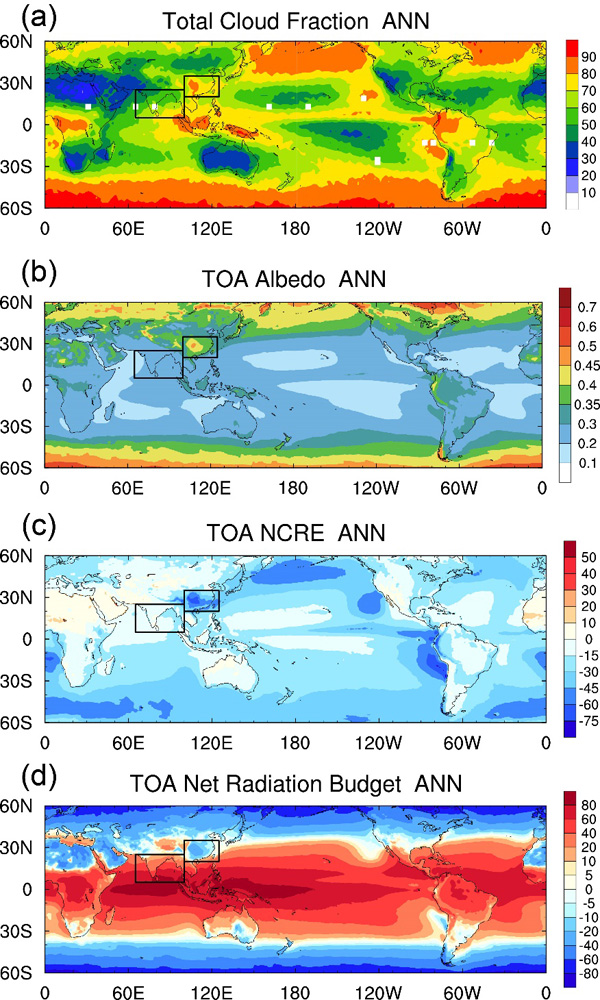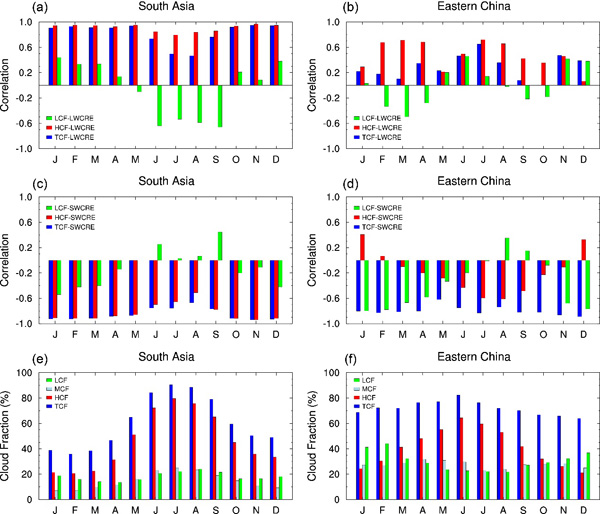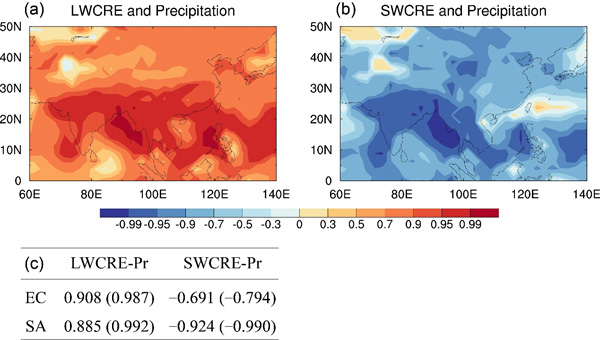State Key Laboratory of Numerical Modeling for Atmospheric Sciences and
Geophysical Fluid Dynamics (LASG)
Institute of Atmospheric Physics, Chinese Academy of Sciences

Vol. 4/No.4 December 2017
[Climate Change] Regional climate: Cloud radiative effects and relevant seasonal variations over Asian monsoon region
Clouds play key roles in energy and hydrological cycle of earth climate system by influencing atmospheric radiative heating, surface energy balance, general circulation and resulting precipitation. The annual cycle is the strongest signal of the Asian monsoon climate. Nevertheless, there has been little research on climatic relationships between cloud radiative effects (CREs) and precipitation or general circulation, and relevant seasonal variations over Asian monsoon region.
Recently, Dr. LI Jiandong (LASG, IAP, CAS) and co-authors use satellite-based observations and reanalyses to investigate the seasonal characteristics of CREs and their associations with CF and precipitation over Eastern China (EC) and South Asia (SA). The CREs exhibit strong seasonal variations but show distinctly different relationships with CFs and precipitation over the two regions. For EC, the CREs is dominated by shortwave (SW) cooling, with an annual mean value of −40 W m−2 for net CRE (Figure 1), and peak in summer while the presence of extensive and opaque low-level clouds contributes to large Top-Of-Atmosphere (TOA) albedo (>0.5) in winter. For SA, a weak net CRE exists throughout the year due to in-phase compensation of SWCRE by longwave (LW) CRE associated with the frequent occurrence of high clouds. For the entire AMR, SWCRE strongly correlates with the dominant types of CFs (Figure 2), although the cloud vertical structure plays important role particularly in summer. The relationships between CREs and precipitation are stronger in SA than in EC, indicating the dominant effect of monsoon circulation in the former region; SWCRE over EC is only partly related to precipitation and shows distinctive regional variations (Figure 3).
Li, J. D., W.-C. Wang, X. Q. Dong, and J. Y. Mao, 2017: Cloud-radiation-precipitation associations over the Asian monsoon region: an observational analysis. Climate Dynamics, 49(9), 3237–3255, doi: 10.1007/s00382-016-3509-5.

Fig. 1 Annual mean a total cloud fraction (%, hereafter TCF) derived from GOCCP (GCM Oriented CALIPSO Cloud Product) during the period 2007–2014, b all-sky albedo, c net CRE (W m−2, hereafter NCRE) and d net radiation budget (W m−2) at the TOA derived from NASA CERES-EBAF during the period 2001–2014. The black boxes represent the Asian Monsoon Regions (AMR) in this study, including eastern China (EC, 20–35°N, 100–125°E) and South Asia (SA, 5–25°N, 65–100°E)

Fig. 2 Annual cycles of correlation coefficients between a LWCRE and c SWCRE and CFs (total cloud fraction: TCF; High cloud fraction: HCF; Middle cloud fraction: MCF and Low cloud fraction: LCF) averaged over SA, respectively. b, d Are the corresponding annual cycles averaged over EC. e, f Are annual cycles of low, middle, high, and total CFs (%) over SA and EC, respectively. The cloud fraction data are from GOCCP satellite retrievals and the period is 2007–2014

Fig. 3 Local correlation coefficients between climatological monthly a LWCRE and precipitation, and b SWCRE and precipitation for the period 2001–2014. c Their regional averaged values over EC and SA, and (in parentheses) the correlations of their regional mean values
E-mail: lasg_newsletter@lasg.iap.ac.cn
Editors: Chuanyi Wang (wangcy@lasg.iap.ac.cn), Kangjun Chen(ckj@lasg.iap.ac.cn)